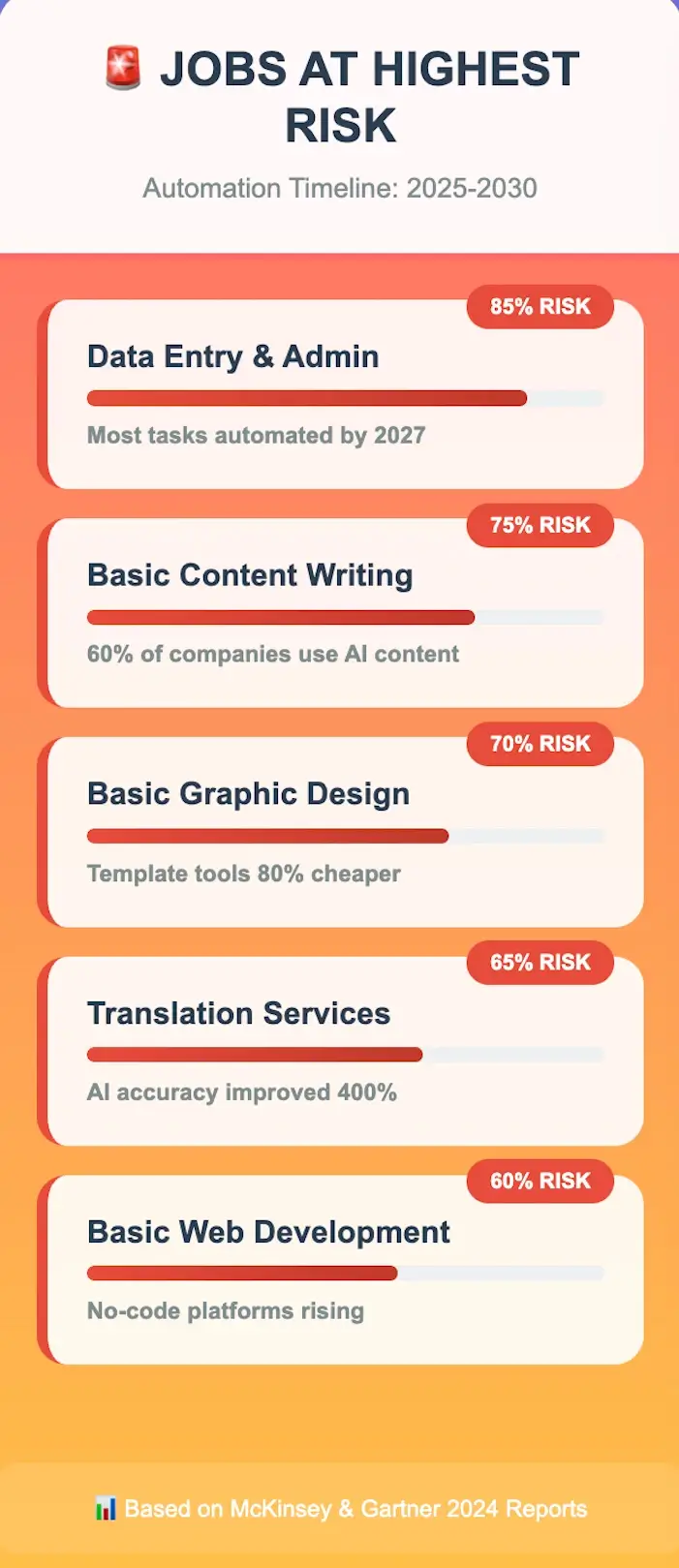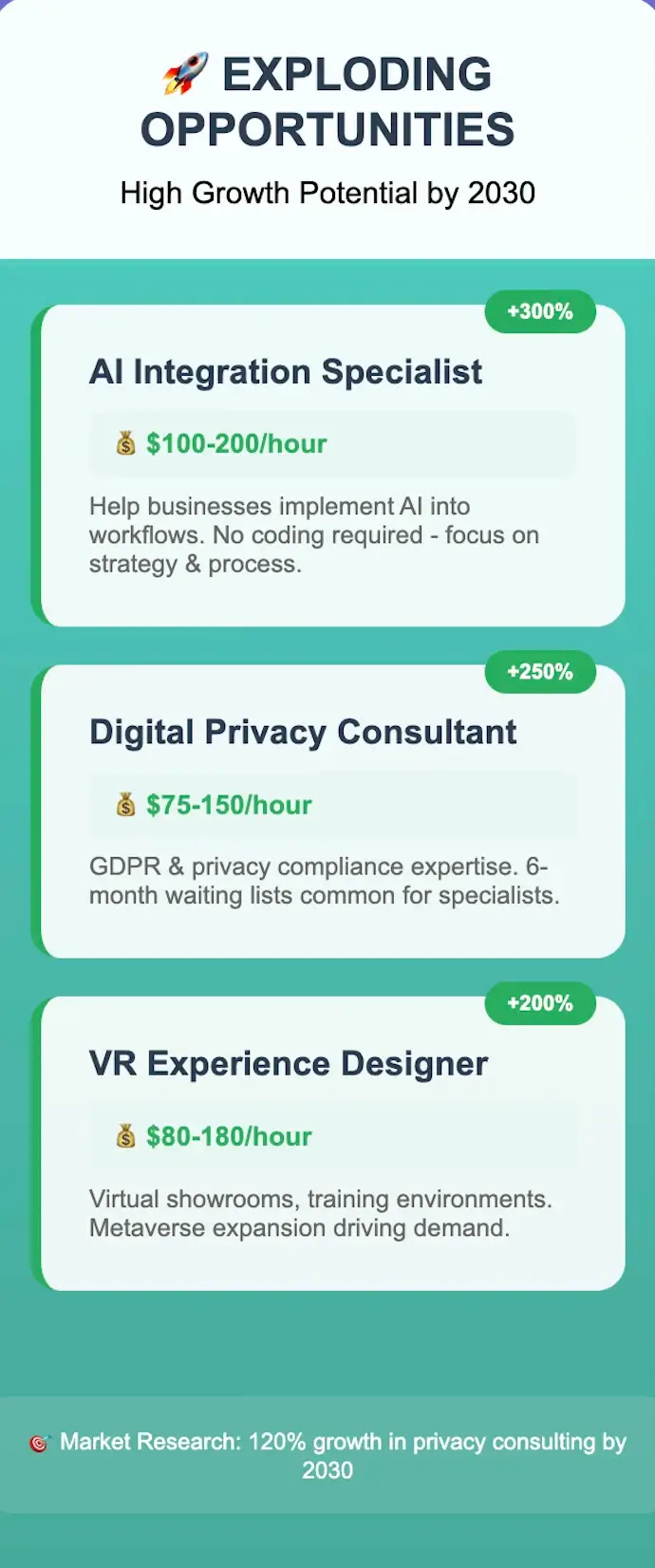Freelance Jobs at Risk by 2030: The Ultimate Adaptation Guide

Introduction
Freelance jobs at risk 2030 is no longer a distant prediction—it’s already unfolding. According to McKinsey’s 2024 workforce report, up to 40% of freelance skills may become obsolete by 2030 due to automation and AI. The freelance landscape is experiencing its most dramatic transformation in decades, and adapting now is the only way to stay relevant and competitive.
The convergence of artificial intelligence, automation tools, and global competition is reshaping what businesses expect from freelancers. While some professionals are still reacting with uncertainty or fear, smart freelancers are already evolving and positioning themselves to thrive in this new economy.
This comprehensive guide reveals exactly which freelance jobs at risk 2030 face the highest disruption, highlights surprising opportunities that are set to surge in demand, and gives you a concrete 5-step action plan to transition into a future-proof freelance career. Whether you’re uncertain about your current niche or excited to explore future-ready skills, this roadmap equips you to not just survive—but thrive—in the evolving freelance economy.
The Top Freelance Jobs at Risk 2030 (and What to Do About It)

1. Data Entry and Administrative Tasks
Risk Level: Critical | Automation Timeline: 2-3 years
Data entry is one of the most vulnerable freelance jobs at risk 2030, as automation accelerates across industries. Gartner’s latest research indicates that 85% of data entry tasks will be fully automated within the next few years. The writing is already on the wall—businesses are rapidly adopting solutions like Microsoft Power Automate and Zapier to eliminate manual data processing.
Anna, a virtual assistant from Portland, shares her reality: “My client base shrunk from 20 steady clients to just 3 after they implemented automation tools. I had to completely pivot my services.”
Future-Proof Alternative: Transform into a process automation consultant. Help businesses identify which tasks to automate and how to implement these systems effectively. The demand for automation strategy is exploding as companies realize they need human expertise to set up their automated processes correctly.
2. Basic Content Writing
Risk Level: High | Disruption Factor: AI Content Generation
Basic content writing is clearly among the freelance jobs at risk 2030, as AI content tools become mainstream. The Content Marketing Institute’s 2024 survey reveals that 60% of businesses now use AI for content generation. Tools like ChatGPT, Claude, and Jasper are producing blog posts, social media content, and even marketing copy at unprecedented speed and quality.
However, here’s the twist: successful freelance writer Marcus Chen didn’t panic when AI arrived. Instead, he learned to work with AI tools and now earns 35% more by offering AI-optimized content strategies and human-edited AI content that converts better than purely automated text.
Evolution Strategy: Shift from basic writing to content strategy and AI collaboration. Become the expert who knows how to prompt AI effectively, edit AI content for brand voice, and develop comprehensive content strategies that AI can’t replicate.
3. Basic Graphic Design
Risk Level: Moderate-High | Threat: Template-Based Design Tools
Canva Pro, Adobe Express, and emerging AI design tools are offering 80% cheaper alternatives to basic logo and graphic design work. Small businesses can now create professional-looking designs without hiring freelancers for simple projects.
Template-based graphic design is increasingly automated, placing it firmly among freelance jobs at risk 2030.
But designer Sarah Rodriguez found her opportunity in specialization. She pivoted to NFT and crypto branding in 2023 and now charges 3x her previous rates because she offers expertise that generic tools can’t replicate.
Adaptation Path: Move beyond basic design into specialized niches like brand strategy, user experience design, or emerging fields like metaverse environments and AR/VR interfaces.
4. Translation Services
Risk Level: Moderate | Technology Threat: Advanced AI Translation
Google Translate’s accuracy has improved by 400% over the past five years, and specialized translation AI is becoming remarkably sophisticated. However, human translators still hold advantages in nuanced, high-stakes content.
While high-stakes translation remains valuable, generic translation is clearly a freelance job at risk 2030.
Legal translator Maria Santos discovered this sweet spot: “I stopped doing general translations and focused solely on legal documents and medical translations. These require human verification and cultural understanding that AI can’t provide. My rates actually increased.”
Survival Strategy: Specialize in high-stakes translation areas like legal documents, medical content, or culturally sensitive marketing materials where human expertise remains irreplaceable.
5. Basic Web Development
Risk Level: Moderate | Disruption: No-Code Platforms
Webflow, Bubble, Squarespace, and other no-code platforms are eliminating the need for basic website development. Small businesses can now create professional websites without hiring developers for simple projects.
No-code platforms continue to push basic web development into the category of freelance jobs at risk 2030.
However, developer Jake Thompson shares his success story: “I stopped building basic WordPress sites and moved into custom e-commerce integrations and API development. I now earn twice as much because businesses still need complex, custom solutions.”
Future Direction: Transition to complex integrations, custom applications, API development, or become a no-code consultant who helps businesses maximize these platforms.
And if you’re considering a complete pivot after realizing your current role is among the freelance jobs at risk 2030, don’t worry—our Start Freelancing Without Experience in 2025 guide will walk you through building a sustainable freelance career from the ground up.
If you’re currently in one of the freelance jobs at risk 2030, here are three smart pivots to explore.
3 Surprising Jobs That Will Explode in Demand
1. AI Integration Specialist
Growth Projection: 300% by 2030
As businesses adopt AI tools, they desperately need experts who can integrate these technologies into their existing workflows. This isn’t about coding—it’s about understanding business processes and AI capabilities.
Freelancer Tom Zhang now earns $150/hour helping companies implement ChatGPT into their customer service, content creation, and data analysis processes. He started with zero AI experience just 18 months ago.
2. Digital Privacy Consultant
Market Growth: 120% increase expected by 2030
With increasing data breaches and privacy regulations, businesses need experts who understand GDPR, CCPA, and emerging privacy laws. This field combines legal knowledge with technical understanding.
Privacy consultant Lisa Chen built her practice from scratch in 2023 and now has a 6-month waiting list for her services, charging premium rates for privacy audits and compliance strategies.
3. Virtual Reality Experience Designer
Opportunity: Metaverse expansion
As VR technology becomes mainstream, businesses need experts who can design virtual showrooms, training environments, and customer experiences. Architect-turned-VR designer Michael Torres now creates virtual real estate tours and training simulations, earning triple his previous income.

🌐 Curious about the decentralized future of work?
Explore how Web3, blockchain platforms, and DAOs are shaping the next era of freelancing in our deep-dive guide — The Future of Freelancing in the Age of Web3 & Blockchain.
Your Action Plan to Escape Freelance Jobs at Risk 2030

Step 1: Skills Risk Assessment
Action Required: Evaluate your current skills against automation and market trends.
Use LinkedIn’s Skills Assessment tool to identify which of your abilities are at risk. Create a simple scoring system:
- Green (Safe): Skills requiring human creativity, strategy, or complex problem-solving
- Yellow (Moderate Risk): Skills that can be partially automated but still need human oversight
- Red (High Risk): Repetitive or rules-based skills easily replaced by technology
Tool Recommendation: The U.S. Department of Labor’s O*NET Interest Profiler can help you identify transferable skills and growing career areas.
Step 2: Two-Tier Learning Approach
Tier 1: Enhance Current Skills Learn AI tools that complement your existing expertise. If you’re a writer, master AI writing assistants. If you’re a designer, explore AI design tools.
Tier 2: Develop Future-Proof Skills Choose one completely new skill area from the high-demand categories. Focus on skills that require human judgment, creativity, or complex problem-solving.
Learning Resources:
- Coursera: AI and machine learning courses
- Udemy: Technical skills and emerging technologies
- LinkedIn Learning: Business and strategy courses
Step 3: Portfolio Transformation
Old Approach: “I write blog posts” or “I design logos” New Approach: “I develop content strategies that increase engagement by 35%” or “I create brand identities that differentiate businesses in competitive markets”
Focus on outcomes and results rather than tasks. Document specific improvements you’ve delivered for clients, including metrics and case studies.
Step 4: Test New Services
Strategy: Launch 3 new service offerings with introductory pricing.
Offer your new services at 50% discount to your first 5 clients in exchange for detailed feedback and case studies. This approach helps you:
- Refine your service delivery
- Build a portfolio in your new area
- Generate testimonials and social proof
Step 5: Network in Your New Field
Weekly Goal: Connect with 2 professionals in your target industry every week.
Join relevant online communities, attend virtual conferences, and engage on social media platforms where your ideal clients spend time. Focus on providing value before asking for anything in return.
Networking Tools:
- LinkedIn: Join industry-specific groups
- Discord: Find professional communities in your niche
- Twitter: Follow and engage with industry leaders
Essential Tools and Resources
Learning Platforms
| Platform | Best For | Price Range |
|---|---|---|
| Coursera | University-level courses | $39–79/month |
| Udemy | Practical skills | $10–200 per course |
| LinkedIn Learning | Business skills | $29.99/month |
| Skillshare | Creative skills | $15/month |
Skills Assessment Tools
- LinkedIn Skills Assessment: Free skill verification
- HubSpot Academy: Marketing and sales certifications
- Google Digital Garage: Digital marketing fundamentals
- Freelance platform analytics: Upwork, Fiverr market insights
Transition Support
- SCORE mentorship: Free business mentoring
- Freelancers Union: Resources and community support
- Industry-specific Facebook groups: Peer support and opportunities
🤔 Still unsure if freelancing is your best path forward? Check out our guide Freelance vs Full-Time Job: Which is Right for You? to compare stability, flexibility, income potential, and long-term growth across both options.
🧭 Want a behind-the-scenes look at real-life freelancing? Read Remote Work vs Freelancing in 2025: My Personal Journey & Practical Comparison for an honest breakdown of both paths, including productivity, mindset, and income freedom.
Frequently Asked Questions
Q: What if my role is one of the freelance jobs at risk 2030 — do I need a total career change? A: Not necessarily. Many freelance jobs at risk 2030 can be evolved into higher-value roles by upskilling and repositioning your services. For example, a basic copywriter can become a content strategist, or a graphic designer can specialize in user experience design.
Q: How long does it typically take to transition to a new freelance area? A: A gradual transition usually takes 6-12 months. You can start offering new services while maintaining existing clients, then gradually shift your focus as you build expertise and client base in the new area.
Q: Where can I find my first clients in a new specialization? A: Start with your existing network—many clients need multiple services. Offer pilot projects at reduced rates to build case studies. Join professional associations in your new field and engage in online communities where your ideal clients participate.
Q: What if I can’t afford expensive courses or certifications? A: Many high-quality learning resources are free or low-cost. YouTube tutorials, free courses on platforms like Khan Academy, and open-source learning materials can provide excellent foundational knowledge. Focus on building a portfolio through practice projects rather than collecting certificates.
Q: How do I know if a new freelance area is worth pursuing? A: Research market demand using tools like Google Trends, analyze job postings on freelance platforms, and join industry communities to understand current challenges businesses face. Look for areas where demand is growing but competition is still manageable.
Your Next Steps Start Today
The freelance landscape of 2030 will belong to those who adapt now—not those who wait until change is forced upon them. Freelancers working in or near freelance jobs at risk 2030 must act early to reposition themselves. The most successful will see this transformation as an opportunity to upgrade their skills, increase their value, and build more resilient careers.
Your immediate action plan:
- Today: Choose one at-risk skill from this article that applies to your current situation
- This week: Research and select one learning resource to develop a future-proof skill
- This month: Enroll in a course or start a practice project in your chosen new area
The future of freelancing isn’t about competing with robots—it’s about becoming irreplaceably human in your expertise, creativity, and strategic thinking.
Worried your freelance role might be one of the freelance jobs at risk 2030? Stay ahead of the curve—join our FreelanceBoosters Telegram channel for weekly updates on high-demand skills, emerging opportunities, and real-world insights from freelancers who’ve already made the transition.
Related Articles:



